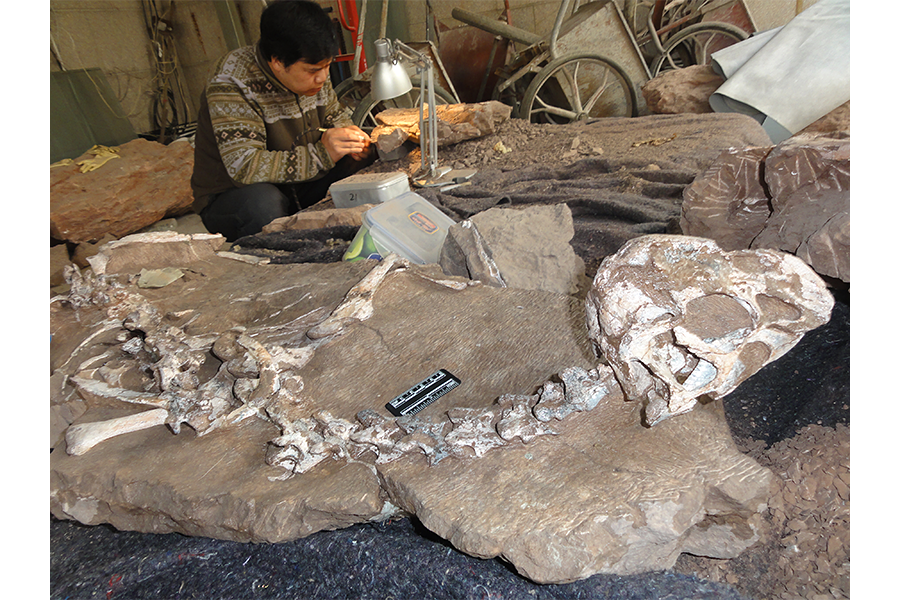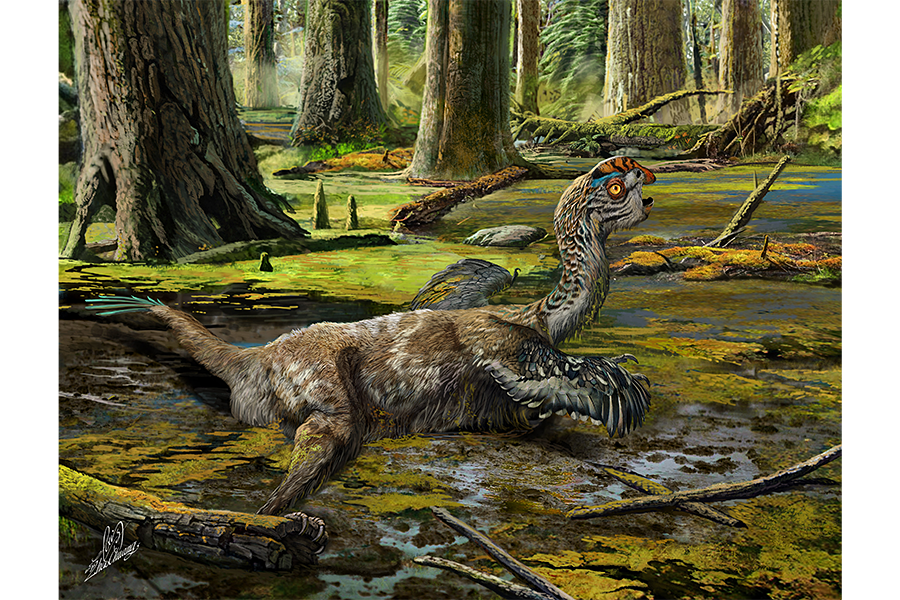'Mud dragon': How a pristine dinosaur fossil was found after dynamite blast
Loading...
Around 72 million years ago, a dinosaur got stuck in the mud. The oviraptorosaur, a feathered, two-legged reptile, probably died mired in the thick, wet earth, with its limbs splayed out, neck outstretched and head raised.
The dinosaur's birdlike body remained trapped in the sediment that had hardened into rock until construction workers blasted into the earth with explosives, revealing the pristine, nearly complete fossil in southern China.
"It was very nearly destroyed by dynamite. We're talking about a matter of inches here – if the dynamite was placed a few inches closer to the skeleton, then we would probably have no record at all that this unique dinosaur even existed," Stephen Brusatte, a paleontologist at the University of Edinburgh in Scotland, writes in an email to The Christian Science Monitor.
But it wasn't destroyed. And now a team of paleontologists, including Dr. Brusatte, announce in a paper published Thursday in the journal Science Advances that the fossil represents a new dinosaur species: Tongtianlong limosus.
"This new fossil is a gorgeous skeleton and one of the best fossils of a dinosaur living in Asia during those final few million years" before the mass extinction that killed the non-avian dinosaurs, Brusatte says. "It gives us this great glimpse at some of the last surviving dinosaurs."
This Cretaceous creature had a bony crest atop its head and a toothless, sharp beak. Although the animal looked incredibly like a bird, it was flightless and ran around on two legs – at least until it was ensnared in mud, as that's how the scientists think the dinosaur met its demise.
"This is another incredible find of an oviraptorid, representing part of an explosion of new specimens and information on these animals that seems to be going on now," Philip Currie, a paleontologist at Canada's University of Alberta who was not involved in the study, writes in an email to the Monitor.
This specimen is the sixth oviraptorosaur unearthed in the same small region of southern China. In addition to the Chinese specimens, similar fossils have been found in Alberta, Canada too, adds Victoria Arbour, a paleontologist at the Royal Ontario Museum in Toronto, who was not part of the research, in an email to the Monitor.
"The large number of species could mean that many of these species lived at the same time and had evolved to fill different niches," she writes. "Alternately, these species might have lived at slightly different times in Earth’s history, and what we are seeing is rapid evolution within this group of small dinosaurs."
Either way finding these many different forms of the same group of Late Cretaceous animals suggests that the oviraptorosaurs, and likely other dinosaurs as well, were continuing to diversify and thrive right up until the mass extinction that killed them all off (except for the birds, the only surviving dinosaurs).
"They were probably the final wave of dinosaur diversification before everything came crashing down," Brusatte says of the oviraptorosaurs. "So they're part of the story that dinosaurs were still doing quite well, still splitting into new species and dominating ecosystems, right up until the end."
Most scientists agree that the dinosaur's extinction story goes something like this: some 66 million years ago a Manhattan-sized asteroid slammed into Earth and triggered massive environmental changes that killed all the non-avian dinosaurs, and many other organisms too.
But there is some debate as to whether or not dinosaurs were already particularly susceptible to extinction when that humongous space rock hurtled onto the scene and finished them off.
"These oviraptorosaurs were not alone" in their Late Cretaceous success, Brusatte says. "They were part of larger ecosystems that also seemed to be doing quite well. There were big tyrannosaurs at the top of the food chain, colossal plant-eating sauropods and duckbilled dinosaurs eating plants, and lizards and turtles living underfoot. Everything seems to be thriving, there is no sign of any decline or decay. And it was type of ecosystem that had to face the asteroid."







